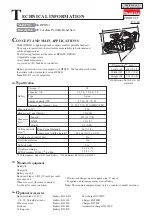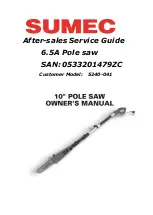
7
English
•
If battery contents come into contact with the skin,
immediately wash area with mild soap and water.
If battery
liquid gets into the eye, rinse water over the open eye for
15 minutes or until irritation ceases. If medical attention is needed,
the battery electrolyte is composed of a mixture of liquid organic
carbonates and lithium salts.
•
Contents of opened battery cells may cause respiratory
irritation.
Provide fresh air. If symptoms persist, seek medical
attention.
WARNING:
Burn hazard. Battery liquid may be flammable if
exposed to spark or flame.
The RBRC
TM
Seal
The RBRC™ (Rechargeable Battery Recycling Corp oration) Seal on
the nickel cadmium, nickel metal hydride or lithium ion
batteries (or battery packs) indicate that the costs to
recycle these batteries (or battery packs) at the end of
their useful life have already been paid by D
E
WALT. In
some areas, it is illegal to place spent nickel cadmium,
nickel metal hydride or lithium ion batteries in the trash
or municipal solid waste stream and the RBRC program provides an
environmentally conscious alternative.
RBRC™ in cooperation with D
E
WALT and other battery users, has
established programs in the United States and Canada to facilitate
the collection of spent nickel cadmium, nickel metal hydride or lithium
ion batteries. Help protect our environment and conserve natural
resources by returning the spent nickel cadmium, nickel metal hydride
or lithium ion batteries to an authorized D
E
WALT service center or
to your local retailer for recycling. You may also contact your local
recycling center for information on where to drop off the spent battery.
RBRC™ is a registered trademark of the
Rechargeable Battery
Recycling Corporation.
Important Safety Instructions for All
Battery Chargers
SAVE THESE INSTRUCTIONS:
This manual contains important
safety and operating instructions for battery chargers.
• Before using charger, read all instructions and cautionary markings
on charger, battery pack, and product using battery pack.
DANGER:
Electrocution hazard. 120 volts are present at charging
terminals. Do not probe with conductive objects. Electric shock or
electrocution may result.
WARNING:
Shock hazard. Do not allow any liquid to get inside
charger. Electric shock may result.
CAUTION:
Burn hazard. To reduce the risk of injury, charge only
D
E
WALT rechargeable batteries. Other types of batteries may burst
causing personal injury and damage.
NOTICE:
Under certain conditions, with the charger plugged in to
the power supply, the exposed charging contacts inside the charger
can be shorted by foreign material. Foreign materials of a conductive
nature such as, but not limited to, grinding dust, metal chips, steel
wool, aluminum foil, or any buildup of metallic particles should be kept
away from charger cavities. Always unplug the charger from the power
supply when there is no battery pack in the cavity. Unplug charger
before attempting to clean.
•
DO NOT attempt to charge the battery pack with any
chargers other than the ones in this manual.
The charger and
battery pack are specifically designed to work together.
•
These chargers are not intended for any uses other than
charging D
E
WALT rechargeable batteries.
Any other uses may
result in risk of fire, electric shock or electrocution.
•
Do not expose charger to rain or snow.
•
Pull by plug rather than cord when disconnecting charger.
This will reduce risk of damage to electric plug and cord.






































